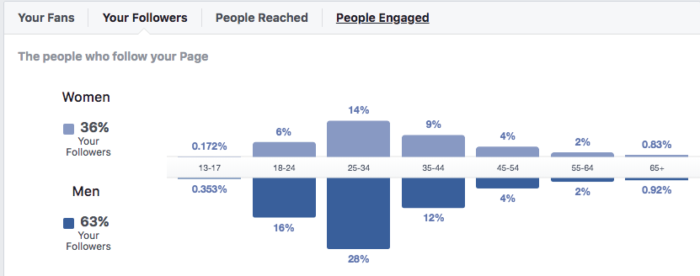
9 Expert Insights to Increase Your Organic Reach on Facebook

You’re likely once exercising Facebook to engage with your audience.
The platform has established itself as indispensable within the social media marketing manufacture with 62% of marketers wording it as the most important point one in their strategies.
But while 93% of marketers use Facebook advertising regularly, 40% say they’re unsure whether their efforts are working.
And that’s becoming an increasingly difficult question to answer.
Because Facebook’s recent algorithm modernize prioritizes announces from family members or friends, little content from business sheets is evidencing up in users’ News Feeds.
In fact, Facebook Ads expert Jon Loomer warns that appraising merely actual, viewable impressions, as to report to News Feed tickings, could see reach lessen by up to 20%.
And as organic contact drops-off, ad paces continue to skyrocket — increasing by 35% in the last quarter of 2017 alone.
So with organic contact on the diminish and advertising becoming more expensive than ever, reaching your gathering on the stage isn’t as easy as it used to be.
But it also isn’t impossible.
Fortunately, Facebook offers a comprehensive package of analytics reports for business sheet owners.
And in this post, you’ll learn nine ways to gather actionable data from these reports, then consume that insight to increase your organic reach.
Why organic reach problems
There’s been a continual recessionin median organic Facebook page reach over the past few years.
And while that may not be story if you’ve been following the social media marketing industry, there was a more drastic descend from 2016 to 2017.
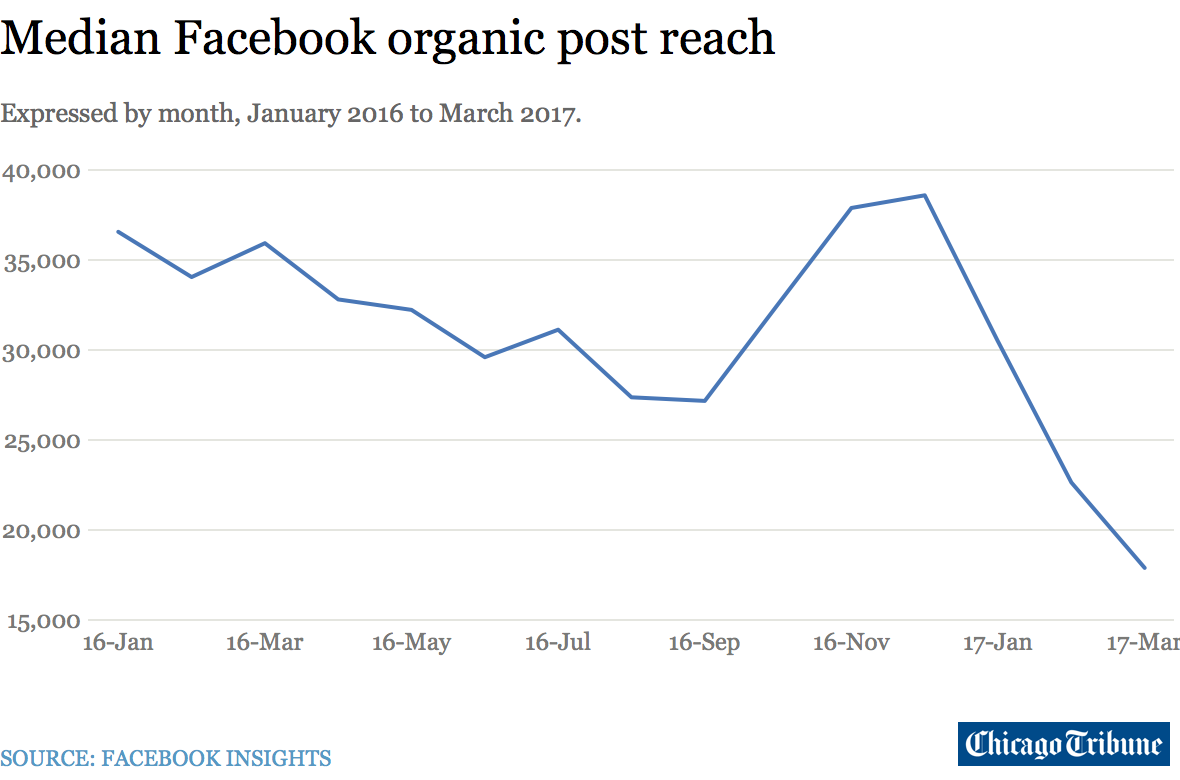
This means that marketers across the board are reaching fewer of their admirers with the content they post.
But why does this matter?
Can’t you simply spend some coin and improve your posts so that they reach more consumers?
That would be the obvious solution — but privately, I don’t recommend it as an alternative to working on your organic reach.
Boosting poles, even with a well-executed programme, is a temporary coming. Once you stop , you stop going results.
Plus, the posts you boost will typically imply guiding users to informational material on your site.
And while that can help you make freight, that congestion doesn’t generally proselytize at a high rate — means that the ROI you picture is very likely to be low.
So while improving uprights is an effective way to generate a spike in commerce to a sheet on your site, it eventually won’t to be translated into long-term results.
Achieving and insisting strong organic reach, on the other hand, can boost your lead contemporary endeavours.
And, having a strong organic reaching, can contribute to your sales pour — making it a much better objective for your Facebook marketing strategy.
How to access Facebook Insights
To access the data that Facebook specifies on your business’s outcomes, you’ll first need to navigate to your sheet and select “Insights” from the menu bar.

The main dashboard shows a epitome of the previous seven days.
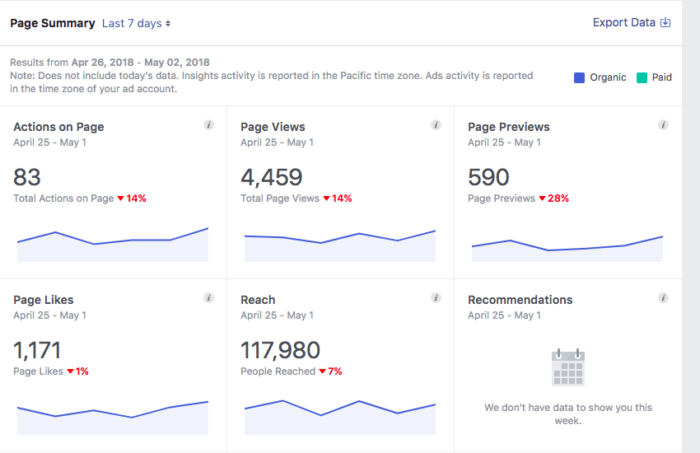
This summary includes data for your total activities on page, pageviews, sheet previews, page likes, sheet reach, and sheet recommendations.
It virtually establishes a general overview of your weekly performance, as well as how that operation compares to the previous week.
From here, they are able to clink any of these epitomes to retrieve more detailed information or scroll down to see data for your five recently completed posts.

This section will show the year and duration of each announce, the post’s type and caption, as well as the reach and commitment achieved.
The reach metric will likewise expose both organic and boosted multitudes if you paid to promote any of your posts listed over the previous seven days.
Finally, your dashboard will also display weekly carry-on summaries of up to five pages that you’ve designated as “Pages to Watch.”
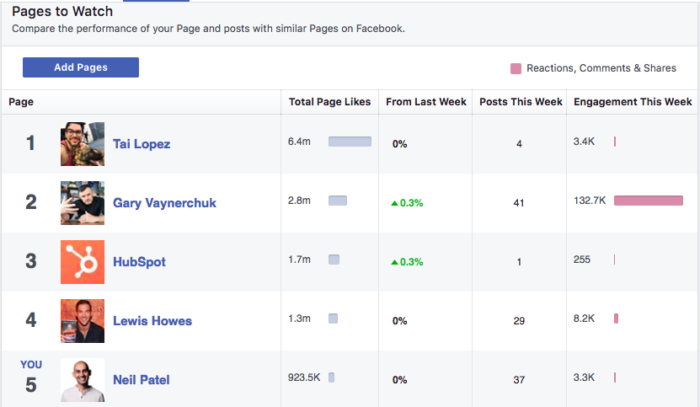
This feature is designed to help you readily compare your page’s performance with your competitors’ pages.
You can add up to five sheets to move. Then this report will display each one’s total sheet likes as well as their increased number of page likes, total affixes, and total engagements.
How to use Facebook Insights to increase your reach
So, reaching your public with organic material is essential for achieving significant decisions with Facebook.
But if your current approaching is just to share links to brand-new material whenever you write it on your website, it’s unlikely you’ll look the type of organic contact you want.
Success on the scaffold asks scrupulous approach and planning.
And when “youre using” Facebook’s built-in reporting feature, Insights, you can discover useful data related to your audience.
This data will help you create a strategy adapted to their interests and browsing habits.
So if you’re looking to improve your results on the pulpit, here are nine ways to use Facebook Insights to measure your carry-on and improve it moving forward.
1. Use the Likes, Comments, and Shares report to identify high-performing content
One of the more popular metrics amongst Facebook marketers is reach.
You can access this data by selecting the “Reach” tab from the line on the left end of the page.
Here you’ll ensure each of these reports showing how many people verified content from your sheet on any uttered day.

This is a supportive report for getting a general intuition of how many people predict or saw your posts over a given time period.
But it doesn’t reveal which material they looked or whether any of those people hired with it.
Of course, you can use this graph to recognize any spikes in reach, then use those spikes as a starting point for delving deeper into your reports.
In that view, it reaches ability to glance at this report whenever you check in on your page’s results.
But you can’t draw definitive or actionable inferences from it.
After all, your goal isn’t exactly to know what your organic contact is — it’s to increase that number.
And one of the best ways to do that is to focus on appointing more engaging content.
When a pole does well in terms of commitment, this signals to Facebook that users find it interesting. As a reaction, they’ll distribute that affixed to even more users.
This means that to attain high-pitched organic reach, you need to create material that generates engagement from your audience.
And you can access this data in the Reactions, Comments, Shares, and More report.
Instead of focusing on reaching, this report will help you identify the days on which your content inspired “the worlds largest” reactions among your audience.
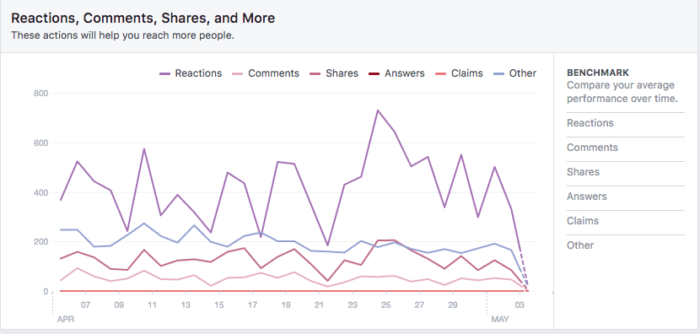
Again, this report doesn’t show individual affixes — so looking at this data alone won’t tell you which material engendered a high number of likes, remarks, or shares.
But formerly you’ve recognized days on which your sheet interpreted high engagement lists, you can use that insight to shrink in on specific posts.
This can serve as a starting point for identifying high-performing content.
Plus, you can use it to determine your overall participation ranks over time.
And while numerous Facebook purveyors mistakenly focus on contact, realise engagement-related metrics a priority will give you a much more accurate intuition of what you’re doing well.
2. Use the Posts report to compare individual berths
After you’ve abused page-wide metrics to get a general sentiment of your Facebook upshots, you can use the Poles report to learn more about the performance of individual posts.
Under the Posts tab, scroll down to “All Posts Published.”
This report will schedule each of your recently-published posts individually, as well as the post’s nature, targeting, contact, and engagement.
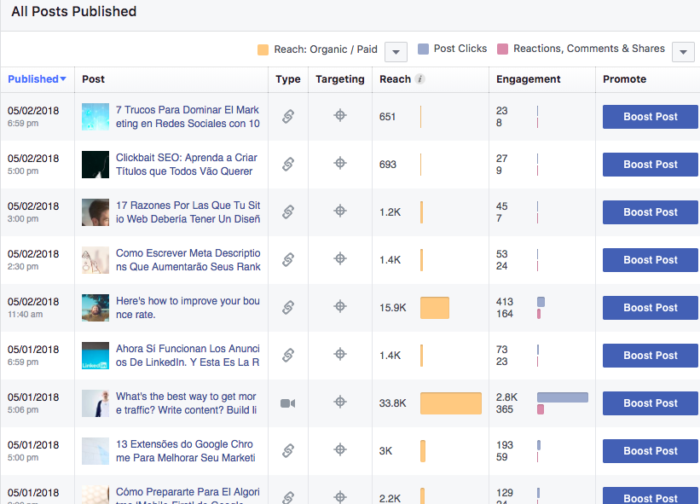
With this data, you can easily specifying the top-performing uprights on your sheet for any given time period.
Here again, though, you’ll want to focus on engagement instead of reach alone.
This is especially important when you consider what this metric certainly marks. Every term one of your uprights appears in a user’s News Feed, it adds to your reaching count.
And when you think about your own browsing garbs, the problem becomes apparent.
Many of us tend to move mindlessly through our feeds, merely stopping when something catches our attention.
And if this is the kind of “reach” you’re generating, it means relatively limited for your business.
If useds don’t stop to speak your material, their view is basically useless.
When a used likes, observes on, or shares one of your affixes, nonetheless, you can be confident that they wasted at the least a few seconds with your content.
This does these metrics more reliable shows of a post’s success. Plus, they can give you a better understanding of which types of content are most interesting to your audience.
Then, you can use this insight to establish more of the content they like — leading to more engagement for your sheet and improving your overall organic reach.
3. Use the Post Types report to learn what your audience craves
Another helpful data set within the Post part of Insights is the “Post Types” report.
This will show the performance of your recently completed poles. But instead of displaying them individually, it evidences data based on all kinds of posts.
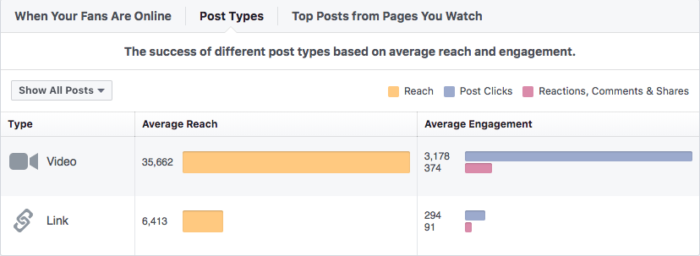
When you produce content to your sheet, you can either announced it in the form of a photo, status, tie, offering, or video.
This report will show which of those types tends to reverberate best with your audience.
After all, every gathering is different.
And while visual material play-acts best on social media, you won’t know for sure if that’s because of your partisans or other types of content they prefer until you dig into your own data.
Of course, as a caveat, it’s important to note that the actual material in these uprights can have an impact on your followers’ responses.
So if you’ve exclusively published one or two posts within the reporting period, information and data may be skewed based on their content.
As a result, this report is most helpful when you’ve been publicizing new berths on a regular basis.
But once it’s had enough time to collect substantial data, you can use it to mold your material calendar and overall strategy.
The more you announce the type of content your public likes to see, the more effective you’ll is currently under rendering date and reaching your goals on the platform.
4. Identify what’s working for your competitors
Looking at pole accomplishment is a great way to ascertain what your gathering wants to see more of. But it’s important to remember that you aren’t limited to monitoring your own content.
Much like with virtually every other figure of digital commerce, doing a bit of contestant experiment is a great way to improve your own strategy.
And Facebook obligates that process easy, as long as you know who your contestants are.
From the Posts tab, hand-picked “Top Poles from Pages You Watch.”
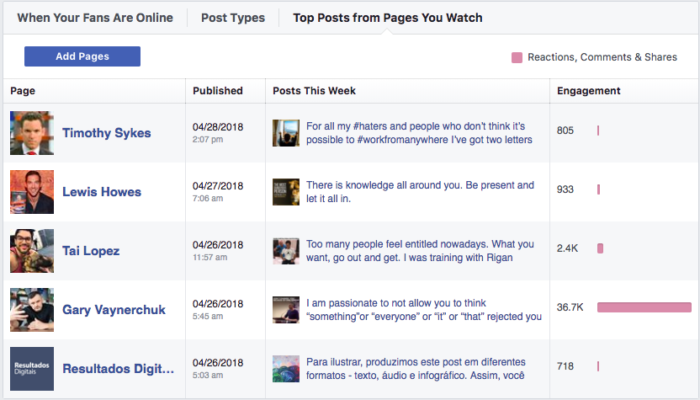
This report registers data from sheets you’ve designated as entrants. And if you haven’t said and done more, you can add to it by selecting the “Add Pages” button at the top of the report.
Then, you’ll ensure the top content from each of the sheets you’ve chosen to monitor to its implementation of engagement.
The report also includes direct links to each berth, establishing it easy to see the exact material that’s working for your competitors.
Assuming that your public shares similarities with the gatherings of the sheets you’ve chosen to monitor, this can be an extremely valuable revelation for your business.
Spend some time investigating which berth forms works for other businesses in your industry, what kinds of topics they’re affixing about, and the flavor and vogue that they use.
Of course, you are able to never is making an effort to repeat another company’s policy directly.
But this is a great way to learn how to most effectively connect with your audience — so that you can create a clearer plan for your own approach.
5. Learn when your followers are online
Many Facebook page admins struggle to identify the best goes to post on social media.
If you spend time composing material, you want to make sure that your public actually investigates it — and timing play games a big role in that.
Fortunately, regulating when your public is online doesn’t need to be a game of guesswork.
Facebook caters all of this data for the purposes of the Posts tab. Simply select “When Your Followers Are Online” from the menu at the top of the report.
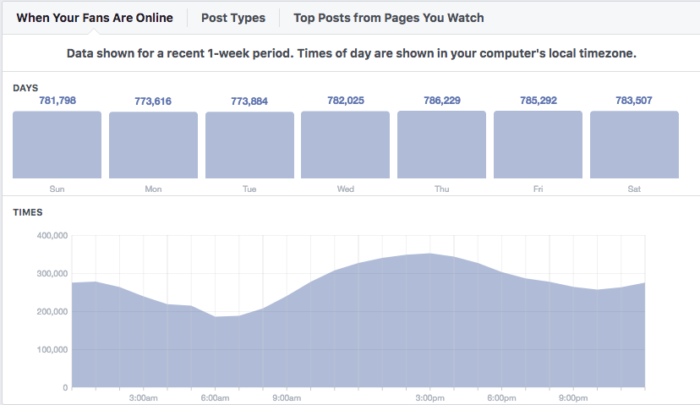
Here, you’ll interpret data from the previous week, testifying your total number of followers active on each day of the week.
Then, once you select a daylight, you can see how many users were active during each hourly interval based on your local time zone.
With this report, there’s no need to guess when “youre supposed” announcing to reach your audience.
Create a schedule based on when you know they’re more actively involved online, and you can be confident that you aren’t missing any openings plainly because of going issues.
6. Use the Net Adherents report to track your audience’s rise
Your organic contact depends on many different factors, the most notable of which is Facebook’s algorithm.
But your uprights will simply ever show up in the feeds of users who’ve chosen to follow you — meaning that your potential organic reaching is limited to that number of users.
That means that it’s important to keep an eye on your audience’s growth.
Fortunately, this is an easy metric to observer use the “Net Followers” report, which you can find under the Followers tab.
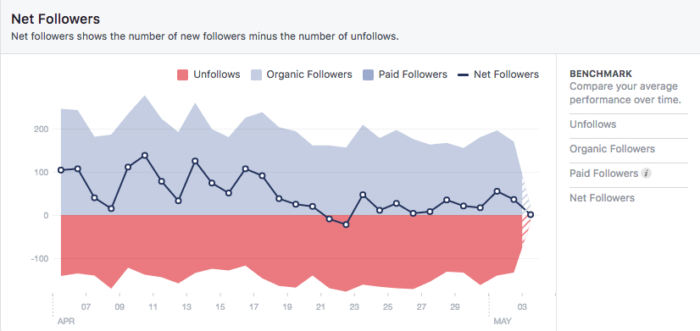
While many sheet administrators focus exclusively on their total number of adherents, that metric doesn’t tell the whole story.
When it comes to growing a sheet, holding your current followers is just as important as earning new ones.
And this report can show you how you’re doing in that regard.
Plus, if you’re lose adherents, this can help you hear why.
If you see a significant number of unfollowers on a specific era, you’ll want to take a look at what you affixed that day.
This can give some insight as to what kinds of content your gathering doesn’t like.
This way, you can bypas publishing the kinds of content that cost your page partisans — and continue to grow your audience.
7. Use the Actions on Page report to see how Facebook drives important business goals
As with any market path, your goal with Facebook marketing isn’t plainly to generate attention on the scaffold itself.
Ultimately, you miss your efforts to translate into meaningful results for your business.
And fortunately, some ventures have looked these types of results abide consistent — or even increase — despite the overall reduced in median sheet reach.
For example, in one Scribewise study, the company verified a 67% multiplication in area freight due to Facebook from December 2017 to January 2018.

So while countless social media marketers were panicking about quits in reach, their results actually improved for a more meaningful metric than how often they appear in users’ News Feeds.
And the data in the Actions on Page invoice can assist you gauge whether your Facebook marketing campaigns are making an impact.
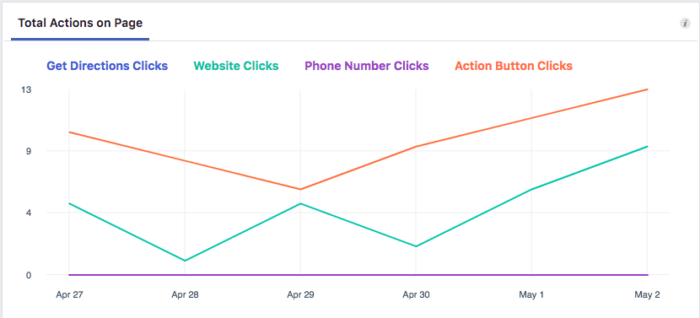
This report establishes whether consumers are taking actions that translate into off-page results.
Actions like ask questions counselings to your business, sounding your telephone number, inspecting your website, or sounding specific actions button on your header.
Depending on your business and social media marketing approach , not all of these actions will be relevant.
For example, if you’re loping an e-commerce storage, you wouldn’t expect your adherents to ask for directions.
But you would want them to visit your website or sounds an act button that addresses them to shop — and this report is where you can see whether they’re taking those steps.
So to make the most of this report, you’ll firstly need to determine what kind of act you’re be expected to drive with your page.
And if you haven’t done so more, you’ll want to create a patronage war button. This will show up in your page’s header and direct visitors to take a gradation that’s important to your business.

Click “Add Button, ” and you’ll be spurred to select from a pre-set directory of button types.
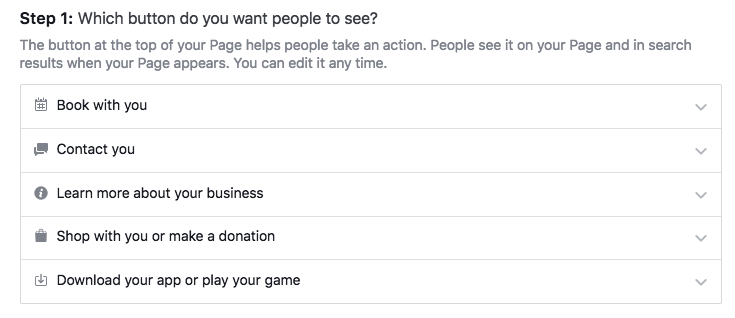
You can opt to direct useds to record an appointment, contact you, see a specific page on your website, supermarket or make a donation, or download an app or game.
Once you’ve computed your button, you’ll be able to trail how many useds click it in the Actions on Page report.
This will give you a clearer idea to seeing how your Facebook strategy is contributing to your overall market goals.
8. Use Video Insights to monitor performance
Today, video is one of the best ways to engage Facebook customers. In point, 12 of the 14 most viral Facebook positions in 2017 were videos.
Facebook has even explicitly stated that video generates more engagement.
It’s clearly a compelling medium — so it should come as no surprise that 81% of purveyors are exercising it as part of their strategies.
And videos don’t have to be complicated or imply high make significances to produce answers, either.
Just take a look at how Inspiralized exploits videos “ve created” Instagram’s Boomerang feature to captivate their audience’s notice 😛 TAGEND

So if you’re not exerting video hitherto as part of your programme, there’s no reason not to try publishing a few simple posts and see how your gathering responds.
Then, formerly you do, Facebook’s Video Insights are a great way to monitor your performance.
Click the Video tab, and you’ll firstly consider an overview of your page’s Video Views.
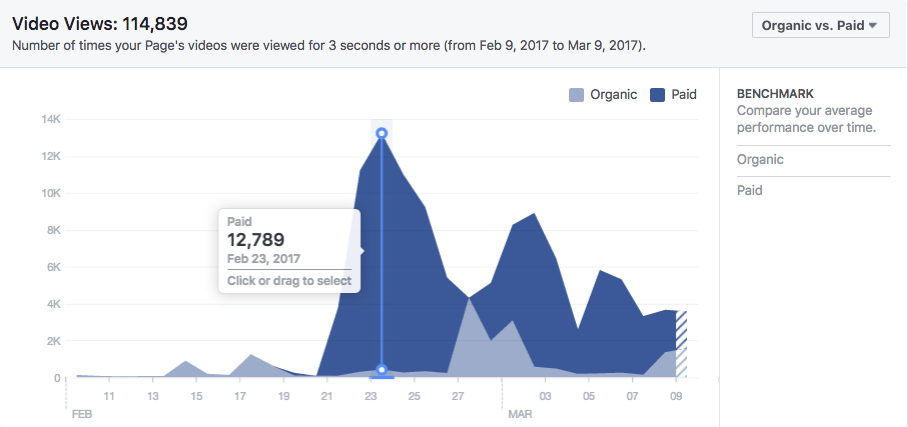
This report countings each time a user watches three seconds or more of one of your videos as a view.
But if you move a little farther down the page, you’ll likewise discover each of these reports demo simply thoughts of ten or more seconds.
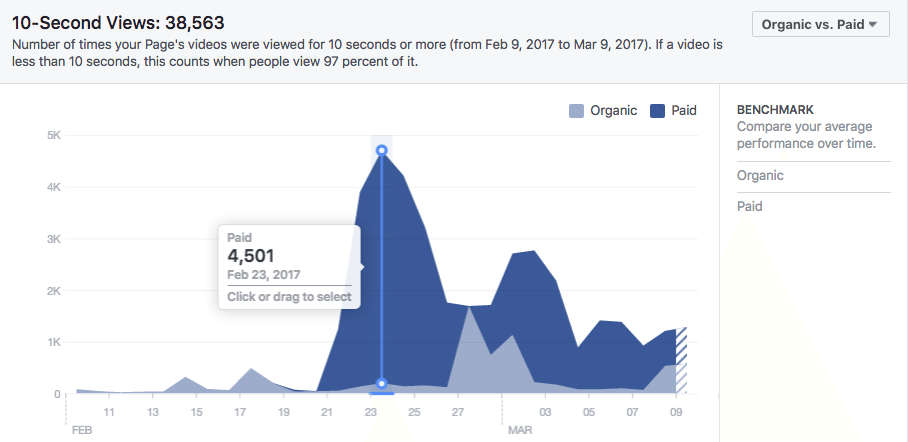
If your video is less than ten seconds, Facebook will instead use this report to show users who watch 97% of it.
Either way, this report is an excellent way to see which of your videos are available to involving your audience.
If a user expends ten or more seconds watching your content, they’re clearly interested — and that means a lot more than the kind of idea included in the standard reaching metric.
From now, you can also click any video to access more data about that individual post.
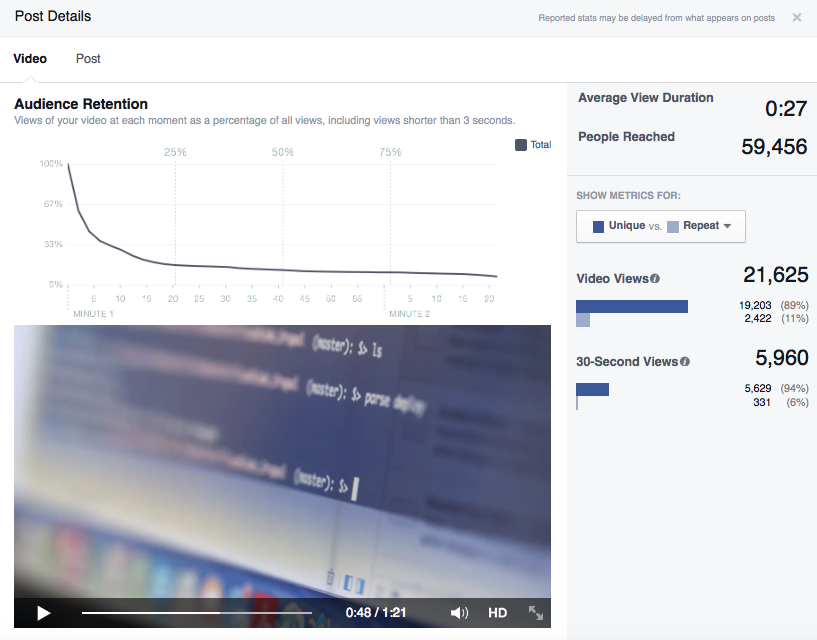
This data includes peak live observers, median watch experience, and total instants viewed.
9. Learn who your followers are
The more you know about your followers, the more effective you’ll be in creating content that’s relevant to their needs and interests.
You can access Facebook’s data about who follows your sheet by steering to the People tab, then selecting “Your Followers.”
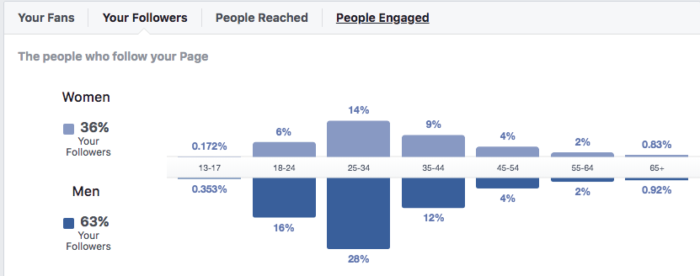
It’s important to be recognised that by default, Facebook will show data on your fans , not your followers.
And while you’ll often realise these terms used interchangeably, there’s an important distinction to make.
Fans “like” your page, but may have opted not to see your posts in their feeds. Adherents, on the other hand, have indicated that they want to see your content.
That means that while these gatherings may be extremely similar, adherents are a better indicator of who’s ensure and interacting with your posts.
Agreement
Engaging your audience on Facebook is no longer as simple as recollecting to write a brand-new upright once or twice a week.
But utilizing the reports above, you can gain priceless insight into your audience’s affairs and browsing habits.
Focus on action rather than reaching because someone who is engaging with your content is more likely to buy than a person who had time moved past it on their News Feed.
Compare post kinds and individual affixes to encounter what’s working for you. Then check out what’s working for your competitors.
Once you know what types of content your gathering likes, catch out when they’re online and post at heyday times so they actually see it.
And don’t forget video. It’s one of the best ways to engage your audience.
Try a few video positions and see how your audience responds.
Finally, track your gathering increment and business goals to make sure your material is connecting.
When you mold your approach around what the hell is want to see, you’ll be much more successful in achieving the reach and commitment you want.
Which metrics do you find most useful when checking your Facebook marketing success?
The post 9 Expert Insights to Increase Your Organic Reach on Facebook seemed first on Neil Patel.
Read more: neilpatel.com

